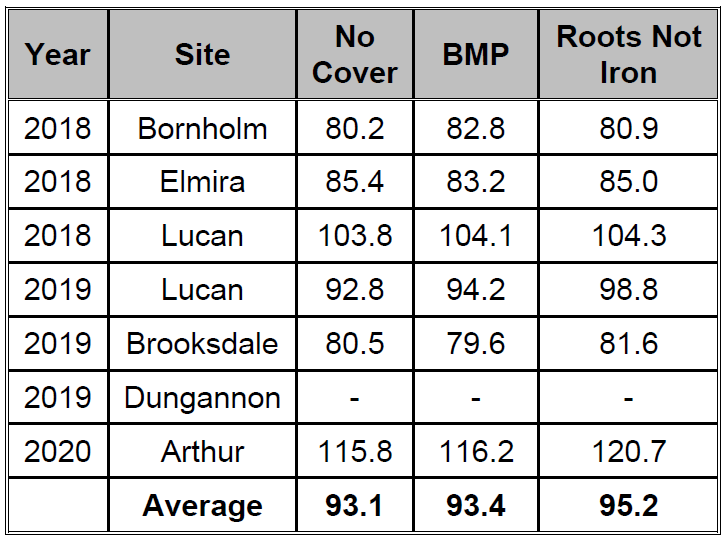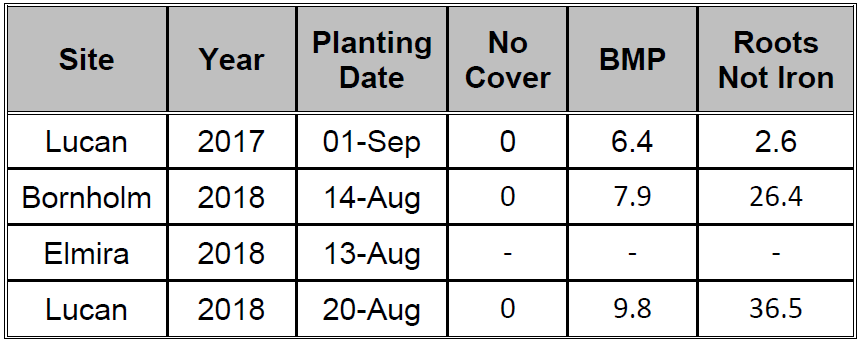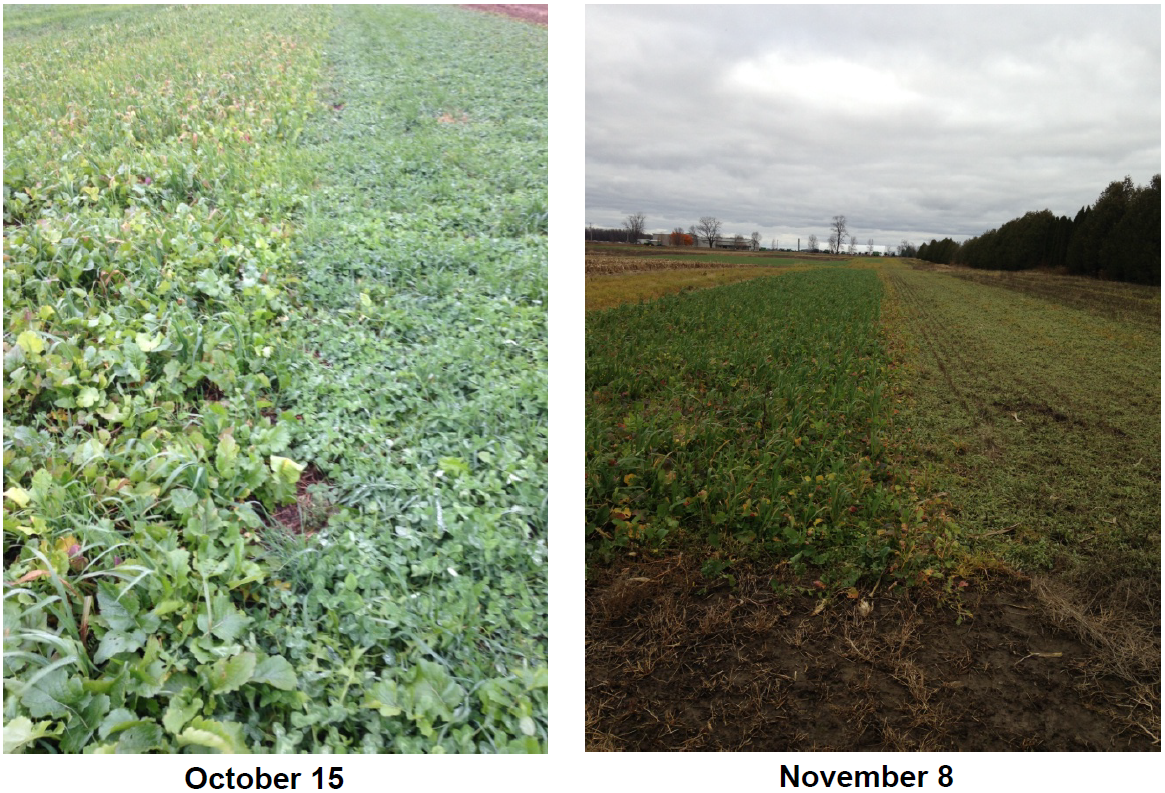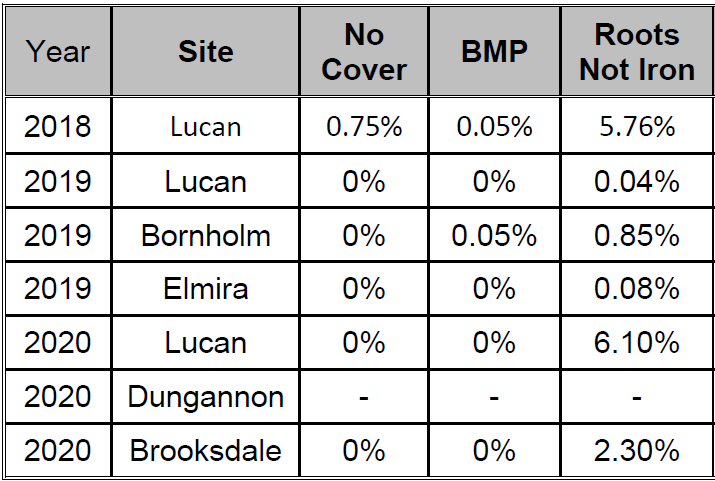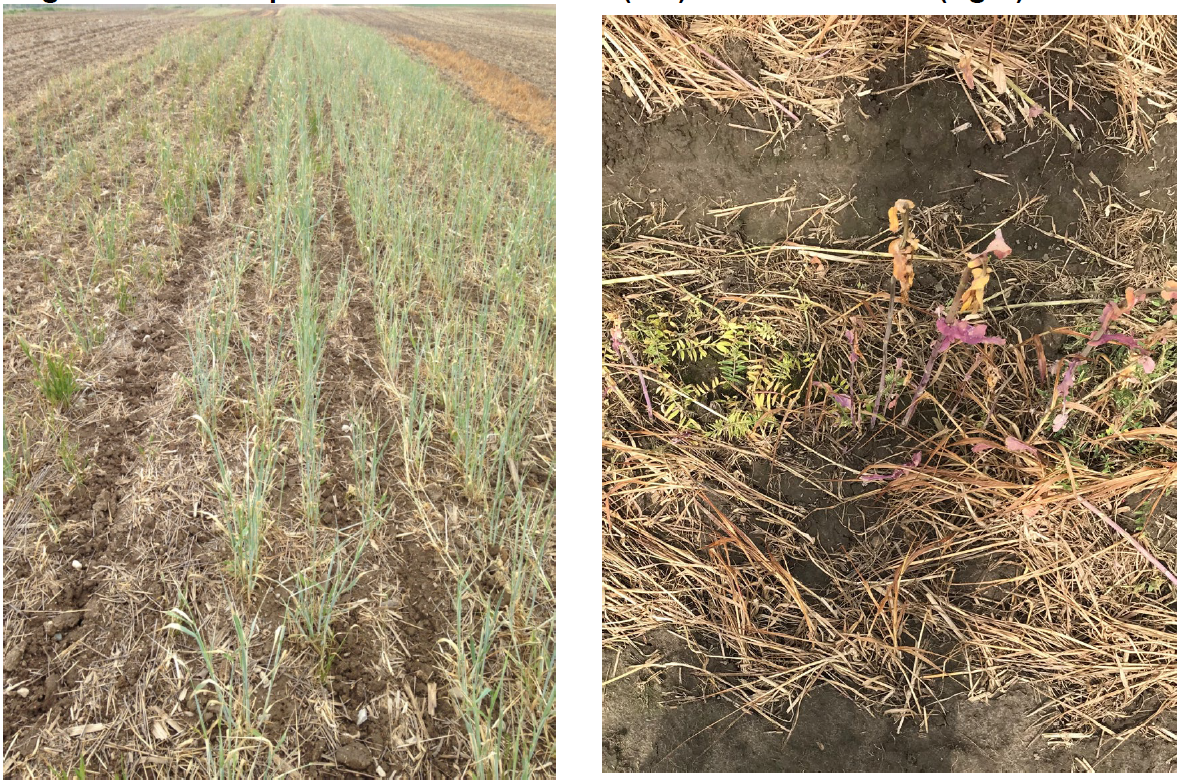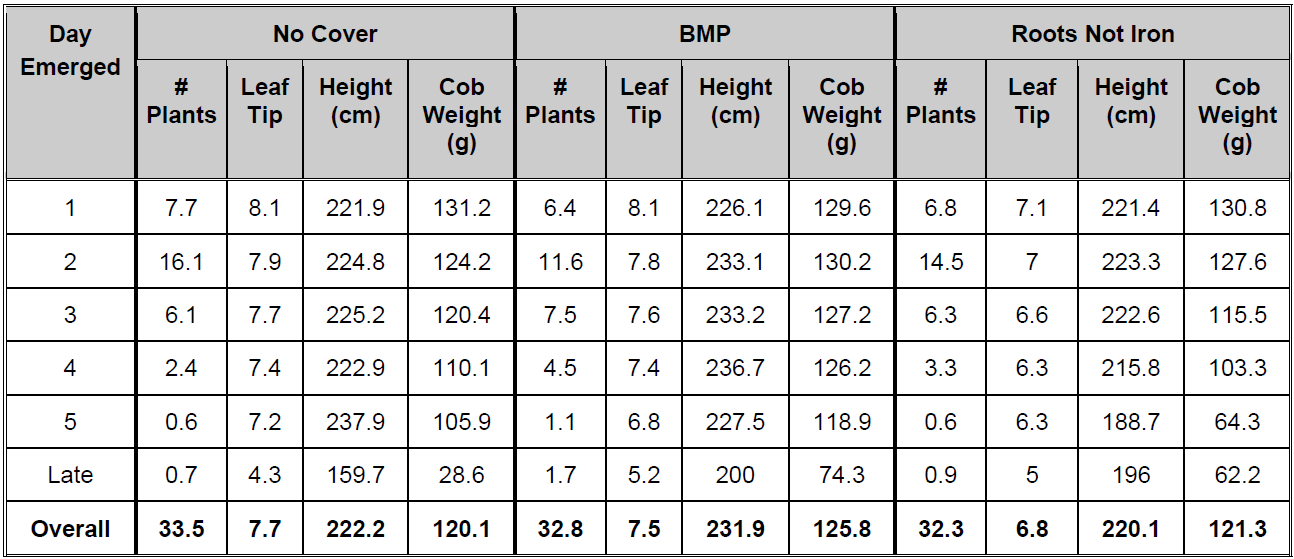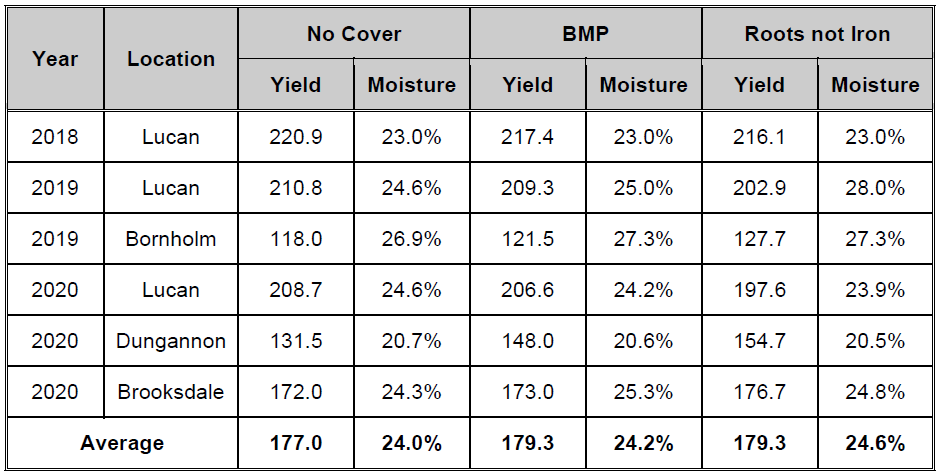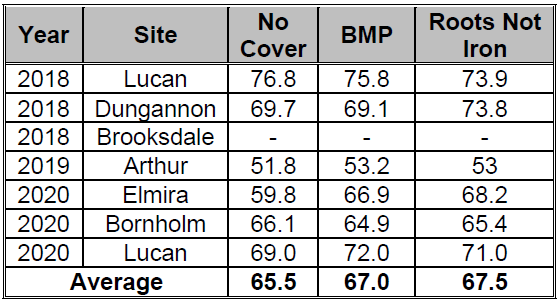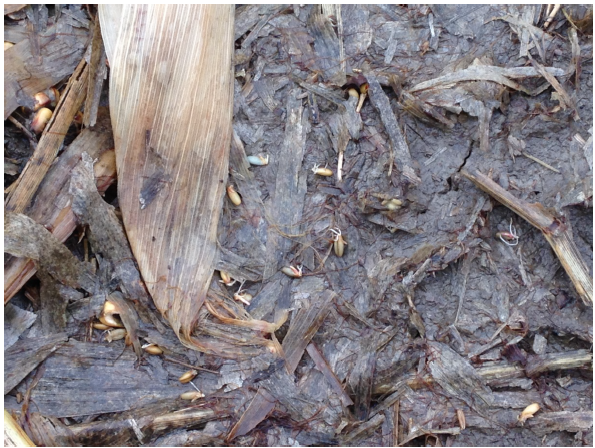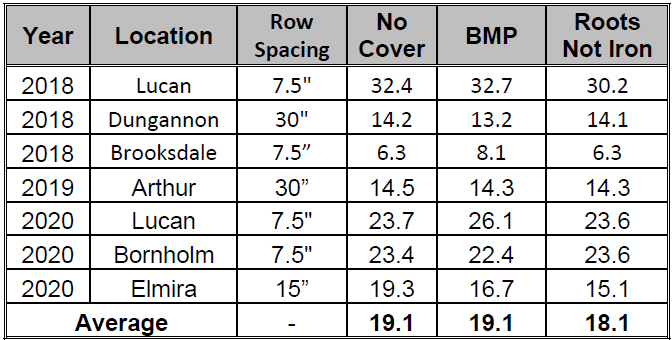Highlights
Purpose
Considerable enthusiasm exists for the concept of having living roots in the soil at all times, but very little data has been available to show yield impacts either long or short term. Unfortunately, while the enthusiasm for this idea is real, there has been a regression towards more tillage in Ontario, especially in certain areas, over last decade. While there is no survey data on this, virtually every agronomist agrees that it is extremely significant & disheartening from both a soil erosion & soil health standpoint.
Coordinated trials for comparative data under Ontario conditions are essential to evaluate if a shift back to cover crops and less tillage can be a sound management strategy for more Ontario farms. The Thames Valley/Heartland Tier 2 project of 2015-2018 (#RootsNotIron 1) showed significant negative impacts on yield in both corn and soybeans in the “plant green” plots compared to other treatments. These yield losses appeared to be associated with poor slot closure, more inconsistent seed to soil and soil to plant contact, and perhaps the green being sensed as a weed by the crop and impacting the growth and development pattern as found by Dr. Clarence Swanton. After 3 years of the project, no increase in soil health could be measured using the Cornell Soil Health Test.
Roots Not Iron 2.0 continued the Thames Valley/Heartland Tier 2 “Roots Not Iron 1” project, with adjustments to the “plant green” treatment that will hopefully overcome the challenges noted above in the original project. The majority of the sites continued on from the original project, to give an extended period of time for soil health improvements to develop and be identified. Note that soil health declines far more rapidly than it can be remediated and farmers working towards enhanced soil health recognize that it is a long-term commitment.
Methods
Three replicate field scale trials were established to continue assessing the Roots Not Iron concept. The treatments continue in the same location at established sites. Minor adjustments were made to the original protocol. The seeding rate of the multi-species cover crop planted after wheat was reduced from 110lbs/acre to 50lbs/acre, and spring strip-till was performed before corn planting to better address slot closure and soil contact issues. Cereal rye planted after corn harvest replaced annual ryegrass interseeded into the corn crop at the V6 stage. Full details of each treatment are listed below.
- Cooperators current conventional practices with no cover crop. Tillage following co-operators normal practice.
- Standard best management of cover crops including clover in wheat (reseed with oat/pea mix if poor establishment), with fall burn down to avoid any green tissue at planting issues. Tillage following co-operators normal practice.
- #RootsNotIron (green all the time). A multi-species (minimum 8 species) cover crop containing a mixture of oats, radish, clover, cereal rye, sunflower, peas, phacelia, and sun hemp will be planted after wheat harvest and left to over winter. The cover crop was strip tilled prior to corn planting and terminated immediately after planting. Cereal rye drilled in the fall into corn stalks immediately after corn harvest and terminated in the spring immediately after no-till soybeans planting.
Baseline soil health assessments (Solvita test for biological activity) and ON-CSHA (Cornell Soil Health Assessment) were taken at the end of the Roots Not Iron 1.0 project and repeated at the end of the Roots Not Iron 2.0 project to measure longer term (6 year) soil impacts, to explore the potential impact on phosphorous movement, nitrogen cycling, organic matter and many other soil health parameters.
Applications of manure as desired by individual cooperators were applied consistently across all treatments and replications, with manure nutrient values taken into consideration.
Results
The wheat yield results are shown in Table 1. The Dungannon site in 2019 was discarded due to variability caused by winter kill. Results were mixed across locations with no significant differences, but an interesting trend was observed. In phase 1 of the project, there was no numerical yield difference between treatments. However, in year 5 (2019) there started to show a slight numerical yield increase to the cover crop treatments, particularly to the Roots Not Iron treatment. This may be an indication of improved soil health having some impact on wheat yields.
Table 1: Wheat Yield Results (bu/acre)
Cover crop biomass measurements were taken in early November. These measurements do not account for root growth but give an indication of how much above ground residue has been created. The Roots Not Iron treatment achieved about 3 times as much above ground biomass as the BMP treatments, but red clover is well known for its root growth, so these numbers may be somewhat overstated. A 70% oats, 30% peas mixture was planted in the BMP treatment at the Lucan locations in both 2017 and 2018 due to poor clover establishment. The fall cover crop growth at the Bornholm location is shown in image 1. The picture on the left was taken on October 15th 2018, while the picture on the right was taken November 8th 2018, two weeks after the clover was desiccated. There is no doubt that the multi species cover crop produced more above ground material than the other treatments.
Table 2: Fall Cover Crop Biomass After Wheat (t/ac wet)
Image 1: Multi-Species Mix and Single Cut Clover (BMP) at Bornholm
The corn results are shown in Tables 3, 4, and 5. In 2018 spring cereal rye growth was variable with some winter kill occurring in lower areas of the field but overall winter survival was good. In 2019 very little rye overwintered while the winter turnip plants did, which was unexpected. Wet weather during the spring of 2019 delayed planting until June at both the Lucan and Bornholm locations. By the time the winter radish was finally able to be terminated it was already in full flower (Image 2). Image 3 shows the amount and colour of the cover crop residue when the corn began to emerge in 2018 and 2019.
In 2018 most of the greenness came from the terminated cereal rye while in 2019 most of the greenness came from vetch. Greenness ratings were taken on the same day as the corn first emerged (Image 3) and are shown in Table 3. As corn is able to sense green plant material before emergence, and it is generally felt to have a negative impact on corn growth and development, low greenness ratings are desirable. The Elmira 2019 photo shows the target of the project: the strip till in the green material producing a black strip without and green plant material, and the balance of the material rapidly dessicating. Greenness ratings were conducted using the Canopeo app, developed by the Soil Physics Research Group at Oklahoma State University. It gives an indication as to how much of the ground is covered by green plant material.
Table 3: Greenness Rating at Corn Emergence
Image 2: Cover Crop Growth May 21st 2019 (Lucan)
Image 3: Cover Crop Growth at Lucan 2018 (left) and Elmira 2019 (right)
Plants were tracked through the growing season to determine the impact that the 3 treatments had on plant emergence, rate of growth, and plant height. Table 4 shows the number of plants that emerged each day based on 5.3 meter length of row (1/1000 acre).
Leaf tips were counted on June 15th in 2018 and July 12th in 2019 (both years about the 8 leaf tip stage). The results from the No Cover and BMP treatments are very similar for plants that emerged on the same day. However, the plants in the roots not iron treatment are almost an entire leaf behind, even when those plants emerged on the same day as plants in the other treatments. This is consistent with the outcome found in the initial project. This is disappointing, as delayed development in the roots not iron treatment was one of the issues identified as negatively impacting yield, and treatments were modified to overcome this delay. Adding strip till to the roots not iron treatment was effective in overcoming the delay in emergence found in Phase 1, but not in maintaining equal rates of crop development. Additional modifications must be considered to overcome this finding. While no data was collected in 2020, general observations would support this delay in development still being problematic.
Plant heights were variable based on day of emergence. Overall the BMP treatment was the tallest while there was little difference in height between the No Cover and Roots Not Iron treatments.
There was a lot of variability in cob weight based on day of emergence but overall there is downward trend in all treatments with delayed emergence. On average plants that emerged on day 3 and day 4 yielded 7.3 and 13.3% less respectively than plants that emerged on day 1. This is an improvement over Phase 1 data, where there was a 6% yield loss per day of delayed emergence, but still shows the importance of uniform emergence, growth and development.
Corn yield results are shown in Table 5. In 2019 the Elmira location was harvested as corn silage and those results are shown in Table 6. On average there is virtually no difference in grain yield between treatments, which is a drastic improvement compared to the results in Phase 1. In Phase 1 the roots not iron treatment averaged 16.6 bu/acre less than the no cover treatment. The improved results for the roots not iron treatment could potentially be due to the introduction of strip-till, improved soil health, or earlier kill of the overwintering cover crop species relative to growth. The locations that had reduced yields in the Root not Iron treatment in Phase 2 tended to have higher greenness ratings at corn emergence (Table 3) and were later planted sites, allowing for increased green biomass to accumulate. At Dungannon 2020, Elmira 2019 and Bornholm 2019 there was a yield increase in the Roots Not Iron treatment, which is a very encouraging sign that soil health may be changing, and that the system has promise.
The soybean yield results are shown in Table 7. The 2018 Brooksdale location had to be reseeded due to variable seedling emergence and the results have been discarded. The results from the 2018 Dungannon location should be viewed separately from the rest of the data as there was no annual ryegrass cover crop seeded in the roots not iron treatment. Due to a severe rain event that occurred on June 22nd 2017 at Dungannon we were not able to inter-seed annual ryegrass into the corn crop. Soybean yields have been outstanding at all locations. Except for the 2020 Elmira location there has been little difference in yield between treatments, which is an improvement from the first stage of the project which showed a yield loss of 2.2 bu/acre with the roots not iron treatment. The major change that was made from the first stage of the project is in the fall of 2018 annual ryegrass at V6 in corn was replaced with cereal rye planted post corn harvest in the roots not iron treatment, making 2019 the first year soybeans were planted into cereal rye during this project. Unfortunately due to wet fall weather in 2018 the cereal rye had to be broadcast following corn harvest as opposed to being planted with a drill. Cereal rye was broadcast at 100 lbs/acre on Nov 22nd at Arthur and Nov 30th at Lucan. Early growth looked promising as shown in image 4, with the rye germinated by Jan 8. Spring rye growth was slow due to cool temperatures. By May 13th many of the rye plants were at the 3 to 4 leaf stage (Image 5). Unfortunately the Lucan soybean location was lost due to uncontrollable circumstances, and thus no data is available for that location.
Table 4. In Season Corn Measurements
Table 5: Corn Yield Results (bu/acre)
Table 6: Corn Silage Yield (tonnes/acre)
A wet spring in 2019 resulted in corn being planted late which pushed corn harvest at many sites to late November. A cold night in mid-December presented an opportunity to frost seed cereal rye at Lucan and Bornholm on December 12th, which resulted in good rye establishment but relatively small rye plants in the spring of 2020. Cereal rye was planted at Elmira on October 23rd 2019 following silage harvest.
Table 7: Soybean Yields
Annual ryegrass has had a negative impact on stand establishment of soybeans over the course of the first stage of the project and again at Lucan in 2018. Except for the 2020 Elmira location cereal rye has had little impact on stand counts. The stand count results are shown in Table 8.
Image 4: Cereal Rye Establishment on January 8th 2019
The soybean population was reduced by 7% at the 2018 Lucan site in the roots not iron treatment. This is consistent with results from Phase 1 of this project which showed a 10% stand reduction in the roots not iron treatment while using annual ryegrass. While the stand reduction did not reduce yields by10%, it does indicate the problems associated with living roots holding tightly to soil, and the difficulties that this can present when attempting to get good seed to soil contact and slot closure at planting. At the 6 locations either without a living cover crop (Dungannon) or very little cover crop growth (2019 Arthur, 2020 Lucan, 2020 Bornholm) stand count results in the roots not iron treatment were similar to the no cover treatment. The substantial stand count reduction at the 2020 Elmira location is likely the result of tillage differences, as the roots not iron treatment was planted no-till while the other treatments received spring tillage prior to planting. The Brooksdale 2018 location had to be reseeded due to variable seedling emergence as seen by the low stand count numbers.
Table 8: Soybean Stand Counts
Summary
There was little difference in wheat yields across treatments. These findings are similar to what was observed in the first stage of the project. There was a trend to slightly increased wheat yields in year 5 and 6 (2019/2020) suggesting the possibility that soil differences may be beginning to be evident.
On average there was very little difference in corn yield across treatments, a drastic improvement from the results seen in Phase 1 where yields were reduced by 16.6 bu/ace in the “Roots Not Iron 2” treatment. It was hypothesized that emerging corn plants sensing the presence of other green plants nearby caused the corn plant to alter its growth pattern, along with difficulty in getting sufficient seed/soil contact through masses of living roots. It is still unclear if the improved results are due to the introduction of strip-till, reduced greenness at corn emergence, improved soil health, or a combination of many factors, but the modifications to the treatment protocols definitely appears to have had a positive impact. Delayed emergence in the Roots Not Iron treatments has been overcome, however delayed development of the corn crop continues to be problematic. In the later years of Phase 2, there is a slight trend to increased yields in the Roots Not Iron treatment, similar to the wheat yields. Hopefully this bodes well for the impact on soil health of the Roots Not Iron treatment.
Soybeans appear to be able to handle the stress of plant green better than corn. Soybeans suffered only minor yield loss when planted into a green cover crop in Phase 1. Beginning in 2019 soybeans were seeded into cereal rye rather than annual ryegrass as in Phase 1. Initial results indicate that cereal rye has less or no impact on soybean establishment, while annual ryegrass showed a 10% reduction in stand. This may be due to the difference in root structure between the two cover crops, or due to reduced cereal rye growth with late fall establishment into the harvested corn crop. Regardless, soybeans seeded into small cereal rye stands appears to have excellent potential from a yield perspective, as long as soil health benefits are sufficient to cover the cost of seeding the cereal rye.
Next Steps
2020 was the final year for the “Roots not Iron 2.0” project. During the fall of 2020 soil samples were collected from each location to compare changes in the soil health assessments (Solvita test for biological activity) and ON-CSHA (Cornell Soil Health Assessment) of each treatment and the results are still pending. This project will hopefully be continued at most locations for two more years. Cereal rye was planted on Nov 9th and 10th following corn harvest at Brooksdale, Dungannon, and Lucan. Winter wheat treatments are in place at Lucan.
Further work in this area of study in future should look at bio-strip till concept where two different cover crop mixes are seeded following wheat harvest. This allows an overwintering mix to be planted in the wheel track area and a winter killed mix in the corn row area. This would reduce the issue of corn plants growing in living roots that prevent good seed-soil contact and avoid having green plants growing too close to emerging corn plants.
Acknowledgements
Huge thanks to our co-operators. Thanks to administrator Marian Desjardine. Special thanks to Cathy Dibble for helping to coordinate sites and data. This project would not be possible without the support and funding of the Ontario Soil and Crop Improvement Association.
Project Contacts:
Peter Johnson, Agronomist, Real Agriculture, pjohnson@realagriculture.com
Shane McClure, Research Lead, shane_mcclure@hotmail.com
Cathy Dibble, Thames Valley SCIA cathy.dibble@ontariosoilcrop.org
Location of Project Final Report:
Peter Johnson, Agronomist, Real Agriculture, pjohnson@realagriculture.com

